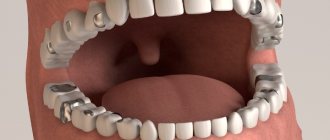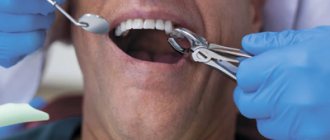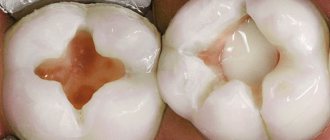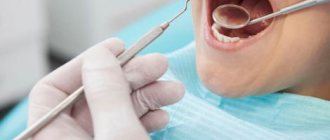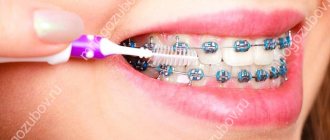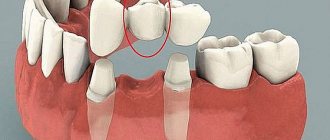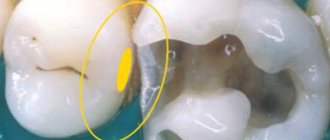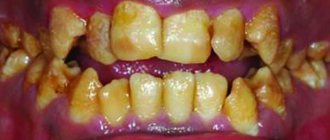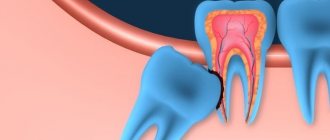3384
Dental implantation is a complex and time-consuming procedure that requires the dentist to have certain knowledge and skills, and consists of a large number of stages.
One of the intermediate procedures at the stage of restoring the integrity of the jaw row is taking impressions from the implants.
This is done with the help of special devices - impression transfers, which are fixed on the implant or abutment.
Concept and purpose
An impression transfer check is a part used in implantology to transfer the correspondence of the location of the implant fixed in the patient’s oral cavity to a working model.
It consists of two elements - a bushing, truncated cone-shaped with a cylindrical neck, and a mounting screw.
The material used to manufacture the device can be medical stainless steel or hypoallergenic titanium alloys.
Use during impression taking allows you to most accurately display the location of the implant or abutment in the jaw row , its inclination, and the position of the internal hexagon, if any.
This reduces the risk of making errors during the manufacturing and fixation of the selected prosthetic structure.
Why are transfers needed?
Transfers in dentistry are analogues of an abutment and are used to accurately transfer the location and inclination of an implant in the oral cavity to a working plaster model.
The transfer consists of two parts - a cylindrical bushing and a mounting screw. The sleeve is a supragingival structure, and the fastening screw is screwed to the implant at the time of taking impressions - exact copies of the jaws, which show the location of the implants and the patient’s own teeth.
Transfers are reliable assistants for both the dentist and the dental technician, since thanks to them, specialists can avoid most of the errors associated with the manufacture and fixation of an orthopedic structure.
Transfers are different, so during the next impression taking (especially when it comes to working with multiple supports on implants), the doctor creates an impression transfer check (in dentistry they are often called “transfers”), which has the following:
- diameter - must correspond to the diameter of the gum former;
- height - it is important that the transfer does not protrude above the rest of the teeth in the row;
- screw length – should not exceed the occlusal plane by more than 5 mm.
Thanks to the transfer check, the initial impression is corrected and brought to a state that best reflects the true situation in the oral cavity. Now you can begin making crowns or bridges.
Taking impressions
During the implantation process, taking an impression of the jaw row plays a very important role. Obtaining a reverse image of the oral tissues in the area of the prosthetic bed allows you to create an exact copy of the patient’s jaw, which displays the location and placement features of the implants and the patient’s own teeth.
Based on the impression obtained in this way, a working model is made in a dental laboratory, which serves as the basis for the further design of a prosthesis or the manufacture of a specific orthopedic structure.
There are currently two methods of taking an implant impression:
- Imprint from the head of the product. The technology is most often used in cases where the decision on the shape and size of the abutment has not yet been made, as well as in the manufacture of a prosthetic structure fixed directly to the implant.
- Impression at the abutment level – used in case of preliminary selection and fixation of the abutment.
In addition, dentists note that in both of these cases, there are two options for taking an impression - open and closed impression tray .
The accuracy of the final result in both cases is the same, however, there are some features that require the choice of a specific type of procedure.
Features of zirconium abutments and advantages of individual products.
Visit here to learn more about the All on 6 implant method.
At this address https://www.vash-dentist.ru/implantatsiya/metodiki/kostnyih-materialov-v-stomatologii.html we’ll talk about the importance of bone material in dentistry.
Features of screw fixation of the prosthesis on the implant
Let us now consider how crowns are attached to implants without the use of cement. Using this method, the prosthesis is connected to the abutment outside the mouth, in a laboratory setting. The prefabricated structure is then screwed to the artificial root using a screw.
The peculiarity of such crowns is the presence of a hole. A screw is inserted into it, which is then tightened using a special tool. After installing the crown, the retainer is masked with filling material.
Material selection
The accuracy of making an impression of the jaw row for further implantation depends on various factors, the key of which is the quality of the impression material.
There are many requirements for the impression material, including:
- biocompatibility with oral tissues;
- high level of elasticity and viscosity;
- tensile strength;
- high resistance;
- sterility and non-toxicity;
- permissible degree of wettability and speed of solidification.
Based on these characteristics, experts most often give preference to silicone masses and polyesters.
In addition to the impression material, great importance is attached to the selection of a suitable transfer. Here the specialist pays attention to three factors:
- Transfer diameter. This parameter must correspond to the diameter of the gum former installed in the patient’s mouth.
When forming the level and relief of gum tissue using a temporary artificial crown, actions aimed at individualizing the standard impression device may be required. - Product height. To ensure that the subsequently manufactured prosthesis does not protrude above the remaining elements of the jaw row, the height of the device must correspond to the height of the teeth located adjacent to the missing one.
- Screw length. The optimal excess of the impression coping above the occlusal plane is 5-6 mm, based on this, the height of the screw should be selected.
Impression of the implant
Before starting to take an impression of the jaw row during implantation, the dentist carries out a number of preparatory procedures:
- when the gingival tissue former is installed, the specialist removes it;
- An impression transfer is fixed to the head of the implant, selected taking into account the technique of the upcoming restoration, as well as the diameter of the gum former and abutment;
- an x-ray is taken to determine the correctness and accuracy of the device’s fit;
- The impression tray is tried on.
Further technology for taking an impression differs somewhat depending on which tray is used - open or closed.
Open spoon
The key feature of the open tray method of taking an impression is that the transfer check is tightly fixed in the impression material, so removing it from the jaw row requires turning out the fixing screw.
At the same time, this impression-taking technique allows not only to record the exact location of the implants, but also to obtain a clear image of the soft tissue relief in the area of the prosthetic bed.
The technology for taking impressions from implants using an open tray is as follows:
- The impression tray is tried on in the patient's mouth. It can be standard or custom made for the patient.
Most often, the product is made of transparent polymer material. This allows you to see the location of the screw and accurately mark the area for cutting holes. - Using a milling cutter or other suitable tool, a hole is cut in the spoon for the unhindered passage of the screw.
- Further steps to take the impression depend on the type of material used. So, when using a mass based on polyvinylsiloxane, it is applied around the devices, after which a spoon filled with the same material is placed in the oral cavity.
The use of monophasic impression material requires its introduction into the area of fixed structures using a syringe, as well as filling the impression tray with liquid mass and its placement in the jaw row.To prevent impression material from leaking through the drilled holes, specialists cover them with base wax.
- After the impression mass has finished hardening, specialists unscrew and remove the screws from the jaw line , after which they carefully remove the tray from the patient’s mouth. The transfers remain firmly fixed in the frozen impression mass.
- or temporary crown, which was removed before the procedure, onto the implant
After taking an impression in the laboratory, an analogue of the implant used is connected to the transfer check using a suitable screw, and an imitation of soft tissue is created around it.
After a thorough check of the position of all components of the structure, a working model is cast according to a standard protocol, on the basis of which the prosthetic structure will be subsequently manufactured.
The video shows the protocol for taking an impression with an open tray transfer.
Closed spoon
A distinctive feature of taking an impression using a closed tray is that after the impression material hardens and the product is removed from the patient’s mouth, the devices remain attached to the implants.
The procedure for making an impression is similar to the technique used in the case of an open tray, but has several distinctive features:
- The structure used when taking an impression with a closed tray can be made of plastic or a metal alloy.
As a rule, it has an outer body and an internal screw, so when fixing it is necessary to check the accuracy of its fit into the polyhedron on the implant before fixing the screw. - Before placing a tray with impression material in the oral cavity, it is necessary to isolate the hole located in the head of the screw fixing the device on the implant using temporary filling material or wax.
This will avoid inaccurate display of the screw surface on the cast, as well as further incorrect positioning of the structure.
The impression is made in two stages. After the initial insertion of a tray filled with impression material, its hardening and removal from the oral cavity, the specialist cuts off the formed interdental septa and other undercuts that may prevent the structure from being re-placed on the jaw row.
After applying the corrective mass to the tray, it is once again fixed on the prosthetic bed, due to which the final impression is formed.
After removing the finished impression from the oral cavity, the specialist carefully separates the transfer from the implant and fixes it in the resulting solid mass.
The previously removed and disinfected gum formers are placed in the intended positions of the implants, and the impression is transferred to the dental laboratory to create a working model.
Watch the video for the process of taking an impression with a closed tray.
From abutment
In addition to taking an impression from the implant, dental practice uses a technique for performing the procedure with a fixed abutment.
It can be carried out in two ways - with or without removing the transfer check from the oral cavity.
Withdrawal along with impression
In terms of technology, this method of taking an impression is practically no different from the procedure carried out when making an impression of the implant head.
This technique uses standard-type impression copings, which are fixed to the abutment with screws.
Standard trays are equipped with special holes that allow access to devices fixed to the abutment.
After the impression mass has completely hardened, the dentist turns the screw, then removes the tray from the patient’s mouth along with the impression structure, which is held in the solid material thanks to its anti-rotation and retention form.
Material and procedure for using a surgical template during implantation.
In this publication we will talk about the cost of express dental implantation.
Here https://www.vash-dentist.ru/implantatsiya/metodiki/tehnika-beskrovnoy.html you will find detailed information about bloodless dental implantation.
Remains in the mouth
The technology of taking an impression and leaving a transfer in the oral cavity is used extremely rarely.
The indication for its implementation is limited access to devices , as a result of which dentists have to use conical-shaped products that do not have retention properties.
The procedure for carrying out the procedure in this case is as follows:
- a standard one-piece transfer check is fixed directly to the abutment;
- the impression mass is distributed over an impression tray, which is placed in the patient’s oral cavity and left there for a certain period of time;
- After the mass has hardened, the spoon is removed from the mouth, the specialist carefully removes the device and fixes it in the frozen cast.
The procedure requires extreme caution, since incorrect positioning of the transfer in the finished impression can lead to errors in the further production of the working model and prosthetic structure
.
Transfers in implantology
At first glance, it is not at all clear to the uninitiated why a crown on an implant will cost almost twice as much as on a regular tooth. It's all about the complexity of the process. To make a traditional crown, you simply need to grind down the tooth, take impressions, measure your bite, and select the color. And that’s it – after a few fittings, the crown can be fixed to the tooth.
In the case of implants, special transfers are indispensable.
Transfers in implantology are structures designed for precise fixation of an implant or abutment into a plaster impression. They are used at the stage of taking impressions.
First of all, transfers are placed on the implants. Further, when taking impressions, it is necessary that the transfers remain in the impression. Implant dummies are then attached to them so that an exact copy of the location in the mouth can be created on the model.
That's not all, an abutment is attached to the model, i.e. an intermediate link between the crown and the structure implanted into the bone. Then it is individualized and the gingival margin is formed. And only at this stage can the dentist begin making the crown according to the traditional scheme - modeling, manufacturing, testing, processing, and so on.
Each of these additional parts has a fairly high price, which is why clinics add them to the cost of treatment.
It is made of stainless steel, which allows the preparation of laboratory models. Comes with double platform. In dental implantology, the so-called evaluation transfer is mainly used. One part of which, using a screw, is fixed to the top of the implant. Then the protective caps are installed. After the base material has hardened, the impression tray is removed from the mouth. Now the doctor must ensure that the transfers are completely covered with the impression material. We remove the transfers from the abutments for screw fixation. The protective caps are installed manually using a hex screwdriver.
The use of transfers helps prevent soft tissue from getting onto the surface of the implant platform.
Before sending to the laboratory, the impression should be washed and disinfected. Careful examination of the print will help confirm key points:
- Stability of the impression coping, which is checked with tweezers. If there is mobility in the impression, it is recommended to redo the impression;
- Accurate imaging of all soft and hard tissues, including teeth.
At this stage, the impression must be disinfected and sent to the laboratory.

